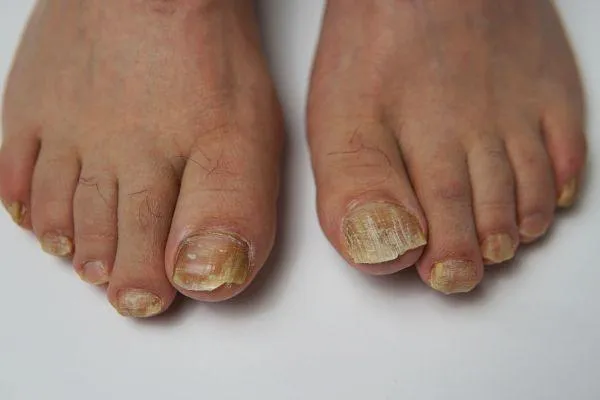
We have all been there, neglected a niggle in our foot and told ourselves that it would probably go away. Weeks have passed, even months, and it’s only getting worse. Then finally, when we are hobbling around barely able to walk, we decide to seek help…
Well, at Achilles Foot Clinic, we are here to help you.

The Connection Between Athlete’s Foot and Toenail Fungal Infections: Diagnosis and Treatment
At Achilles Foot Clinic, we frequently encounter patients dealing with fungal infections that affect both the skin of the feet and the toenails. Two of the most common issues are athlete's foot and toenail fungal infections, which can often coexist, complicating treatment and recovery. Understanding the relationship between these conditions is crucial for effective diagnosis and treatment. In this post, we’ll examine how athlete's foot and toenail fungus are connected, the best ways to diagnose them, and the most effective treatment options available.
Understanding Athlete’s Foot and Toenail Fungal Infections
Athlete’s Foot (Tinea Pedis): This fungal infection primarily affects the skin between the toes and on the soles of the feet. It is caused by dermatophytes, a type of fungus that thrives in warm, damp environments. Symptoms of athlete’s foot include itching, burning, redness, and peeling skin.
Toenail Fungus (Onychomycosis): This infection targets the toenails, leading to thickened, discoloured, and brittle nails. It can be caused by the same dermatophytes as athlete’s foot, or by other fungi and yeasts. Toenail fungus may start as a minor issue but can lead to more serious problems if left untreated.
The Link Between Athlete’s Foot and Toenail Fungus
Common Pathogens: The fungi that cause athlete's foot can easily spread to the toenails, especially if proper foot hygiene is not maintained. The same fungal spores may infect both areas, creating a cycle of infection that can be challenging to manage.
Environmental Factors: Both conditions thrive in similar environments, such as locker rooms, swimming pools, and communal showers. Individuals who have athlete’s foot are at a higher risk of developing toenail fungus if they do not take appropriate preventive measures.
Compromised Skin Barrier: When athlete’s foot causes skin breakdown, it can create an entry point for fungi to invade the toenails. This means that addressing athlete’s foot is crucial in preventing toenail infections.
Diagnosing Combined Infections
Accurate diagnosis is vital for effective treatment. Here’s how healthcare professionals typically approach diagnosing these conditions:
Clinical Examination: A thorough examination of the affected areas is essential. The healthcare provider will look for signs of athlete’s foot, such as peeling skin and inflammation, and inspect the toenails for discoloration and thickness.
Microscopic Examination: A sample of skin or nail may be taken for microscopic analysis to confirm the presence of fungal elements.
Fungal Cultures: Culturing samples from the affected areas can help identify the specific type of fungus, guiding appropriate treatment.
Treatment Options for Athlete’s Foot and Toenail Fungus
Treating both athlete’s foot and toenail fungus requires a comprehensive approach that targets the infections effectively. Here are the common treatment options:
Topical Antifungal Treatments:
For Athlete’s Foot: Over-the-counter antifungal creams, sprays, and powders can effectively manage athlete’s foot.
For Toenail Fungus: Topical antifungal nail lacquers may be prescribed, though they can be less effective for severe cases.
Oral Antifungal Medications:
For toenail fungus, oral antifungal medications such as terbinafine or itraconazole may be necessary, especially if the infection is extensive or resistant to topical treatments.
Proper Foot Hygiene:
Keeping feet clean and dry is essential in preventing the spread of infection. Wash your feet daily, dry them thoroughly, and consider using antifungal powders to keep them dry.
Nail Care:
Regularly trim and thin the affected toenails to reduce fungal load. In severe cases, partial or complete nail removal may be necessary to facilitate treatment.
Environmental Measures:
Disinfect shoes, socks, and surfaces that come into contact with your feet. Fungal spores can persist on surfaces and reinfect the feet.
Follow-Up Care:
Regular follow-up appointments with your podiatrist are essential to monitor your progress and adjust your treatment plan as needed.
Conclusion
Understanding the connection between athlete’s foot and toenail fungal infections is vital for effective diagnosis and treatment. By addressing both conditions comprehensively, you can improve your chances of achieving clear, healthy skin and nails.
If you're experiencing symptoms of athlete’s foot or toenail fungus, or if you have any questions about your foot health, don’t hesitate to contact Achilles Foot Clinic. Our expert team is here to provide personalised care and help you find effective solutions for managing and treating these common fungal infections.
Contact us today to schedule a consultation and take the first step towards healthier feet!
Ask Lorcan And His Team
Fill in the form to request a Call From Our Team
Fill in the form to request a Call From Our Team
One of our team will call you for FREE and answer any questions or concerns you may have about Bunions.
One of our team will call you for FREE and answer any questions or concerns you may have about your uncomfortable Bunions.








